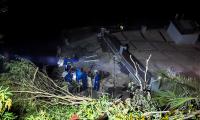In Part I of this column (published yesterday – Sep 30), I stressed the need for decision-makers to support the private sector through a robust mechanism of consultation.
A successful industrial policy would bring about a continually evolving comparative advantage in the economy. This means success in a broad range of sectors and not concentrating in just a few areas. Also, the economy must not stay static. Manufacturing must continually go up the value chain.
Why have past efforts to industrialize not worked? In the 1960s and 1970s, Pakistan set up capital intensive industry in the public sector. Unlike what PIDC did before, the government of Pakistan did not privatize these PSEs. Inevitably, the government could not spare the resources to maintain their profitability with new technology or quality workers. More importantly, there was no spillover. Few new industries flowed from them.
So, we have Pakistan Steel, HMC, HEC, a shipyard as well as a locomotive manufacturing factory. They either lie abandoned, are grossly underused, or are serving a purpose other than that for which they were meant. In FY22, we imported iron and steel worth over $5 billion. With the economic slowdown, imports have since fallen, though they are still substantial while the steel mill produces nothing.
Industrial policy can show results even in the short term. In 2010, ADB published a study titled ‘Pakistan: Competitiveness and Structural Transformation in Pakistan’. Ricardo Hausmann, a Harvard development expert of world renown was the lead author. The study avers that within Pakistan’s present capabilities, the economy had limited room to expand. At the time of drafting the report in 2010, Pakistan’s GDP per capita compared well with that of India and Indonesia. Yet, it had a less sophisticated export mix. The report said that production of new goods by Pakistan needed a jump in its capabilities.
While the industry of other economies progressed, Pakistan had fallen behind. It had not invested in human resources and essential infrastructure, the report informed. In fact, industrialization did not seem to be a priority for Pakistan. The situation has not changed since.
It was still possible to make a break. As per the report, there was low-hanging fruit that the private sector could quickly benefit from. These were goods that Pakistan produced for the home market but was not exporting sufficiently. They included frozen food, cut stone, bakery goods, mattresses, detergent, jewelry and silverware. Electric fans and some pharmaceuticals also fall in this category.
Also, there were intermediate goods, parts and components that Pakistan produced and could export with some improvement. Value-added agriculture is being exported in small quantities. It is possible to boost their export through better packaging, branding and processing. The government should help with the needed public inputs to enable export of these goods.
A large part of Pakistan’s sizable and growing population of young people was unskilled, and without access to formal jobs. Pakistan has a high population growth rate along with one of the lowest rates of secondary school enrollment in the region.
A clear goal for Pakistan should be labour-intensive activities that employ unskilled workers. To create jobs for them, the report identified that the government of Pakistan should support the sectors of logging, cattle raising and wood and metal goods manufacturing. It also recommends many other areas, including manufacturing of leather goods, ceramic wall and floor tiles, clay refractory, gypsum products, concrete products, cut stone goods and asphalt shingle and coating. The report also recommends farming more sugarcane and beetroot, oilseeds and tree nuts.
The report also advises that Pakistan should later push the production frontier to fabricated metal and plastic goods including for buildings and structures.
Though Pakistan’s industrial structure has not changed since the writing of the report in 2010, the government should source technical assistance to update it as well as to implement the industrial strategy. The technical assistance could also support the government to institutionalize the dialogue process with the private sector. It would train public officials to gain knowledge about the industries selected for support.
The East Asian growth economies went through a similar process. They moved up from low-tech production by small firms that gradually became internationally competitive. From there the economy graduated to mass production of textiles, shoes, toys and furniture to dominate the globe. Before long, they began producing intermediate goods. As exports rose, the economy had the foreign exchange to set up basic industries. These are the means of mass production, such as steel, chemical, petro-chemicals – goods on which other industries rely. Throughout this long process, governments actively helped industry with public goods, credit and ideas.
South Korea too followed a similar, though more capital intensive, route. It did not heed outside advice to keep producing more rice. Starting in 1962, its five-year plans had industrial transformation as their goal. Each plan aimed for ever sophisticated production. In parallel, it also had a plan to transform village communities.
The institutional setup needed for the success of the industrial policy must have top level involvement. This would ensure buy-in by all parts and levels of the government. Again, the SIFC is an ideal institution to do so. It can put in place the needed processes to ascertain the most appropriate support for industrial growth. It can ensure that the government enforces the benchmarks and criteria for firms to achieve.
There are some areas to which the private sector has drawn the government’s attention. There is an urgent need to remove the disincentives that manufacturing faces. For example, non-export sectors such as IPPs, auto assembly and construction enjoy preferential tax and regulation differences over manufacturing. Also, manufacturing bears a disproportionate burden of taxation. These differences divert investment from manufacturing to lightly taxed areas.
Of late, much has been done to limit goods filtering into Pakistan via the Afghan Transit Trade. To secure it fully, there should be agreed limits on import volumes aligned with market demand in Afghanistan. Or Pakistan Customs may collect Afghan rate duty at point of entry and transmit to Afghanistan when goods have crossed the border. Pakistan also needs to urgently set up SEZs and STZs.
The Pakistan Standards and Quality Control Authority must enforce internationally accepted standards for all goods produced here, especially those for export. This way we can do away with Pakistan’s image as a supplier of low quality goods. The PSQCA must have the authority to upgrade standards, check the quality of export goods and to penalize infringements. They must have decentralized offices in most parts of the country, especially in or near industrial estates.
When space and international agreements permit, Pakistan may launch a TERF-like financing facility for priority industries. It must also offer long term finance for SMEs and help them to avail the credit. Without this industrialization cannot grow. There is also the need to urgently revive DFIs. In fact, we can trace the decline of industry in Pakistan to the reduction of credit from DFIs. There is no long-term, fixed rate project financing in Pakistan. Because of the government’s massive credit needs, banks have been unable to finance private projects. This must change. The government must mandate banks to now shift their focus back to banking.
Lastly, I recommend that the government budget the cost of its interventions to support the industrial policy. It must set aside about 0.25 to 0.3 per cent of GDP annually for help to industry. At current levels, this amounts to between Rs250 billion and Rs300 billion annually. This is in addition to PSDP and other ongoing support. The investor will have the comfort that support will be available for the promised duration.
This amount may cover the expense of training and upgrading of skills. It should also improve the quality of infrastructure and economic services. These funds would assist with engaging foreign experts, obtaining licenses, helping industry meet international compliance and upgrading R&D. Pakistan must urgently re-orient the PSDP, so that public investment directly boosts economic growth, including industrialization and exports.
Concluded
The writer is chair and CEO,
Institute for Policy Reforms.
He has a long record of public service.
Critics argue that strategy is vague, but closer look indicates strategic alignment with global trends and national...
To defeat it, we must distrust bot-driven narratives, to defeat it, we must verify sources before believing or sharing
Too often in emerging markets, digital innovation is treated as standalone goal, with risk relegated to afterthought
As in Pakistan lawfare’s impact and prevalence are increasing, situation is turning murkier
Number of traditions are associated with Eid, such as new clothes and giving and receiving of cash gifts as Eidi
Internationally, there have been misleading theories propounded about so-called slowing of Chinese economy







